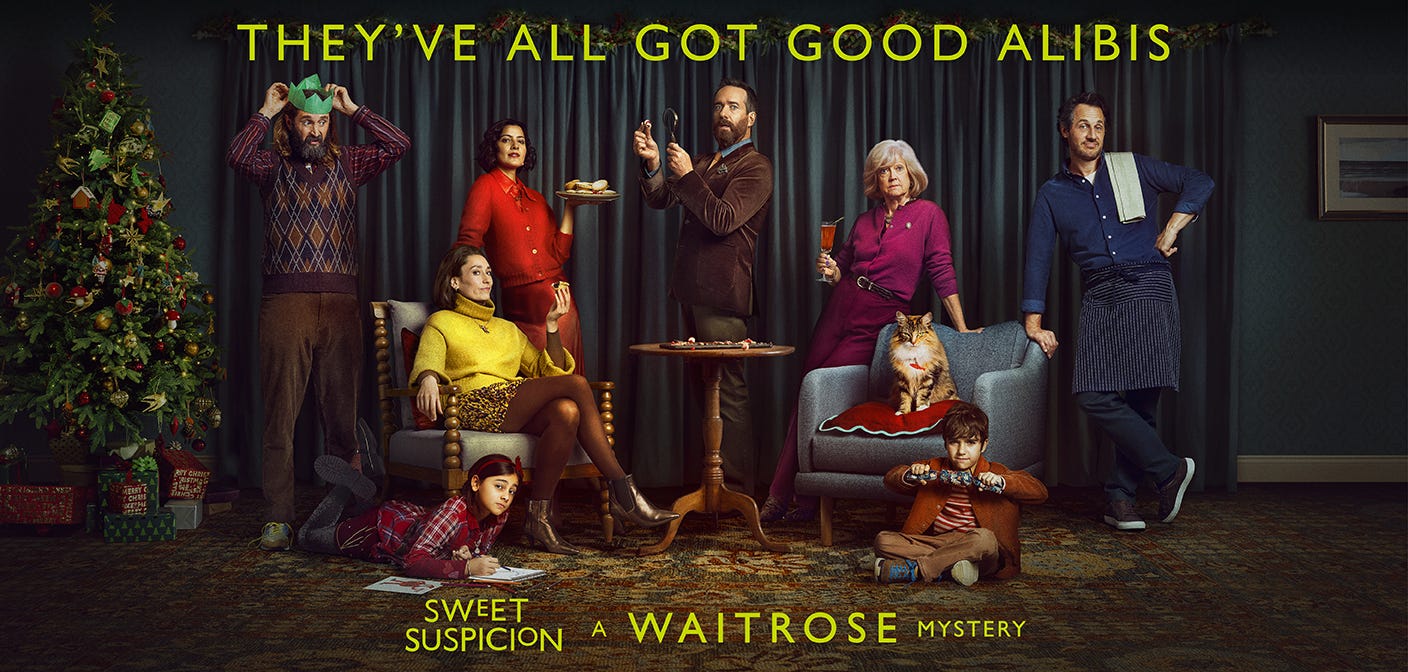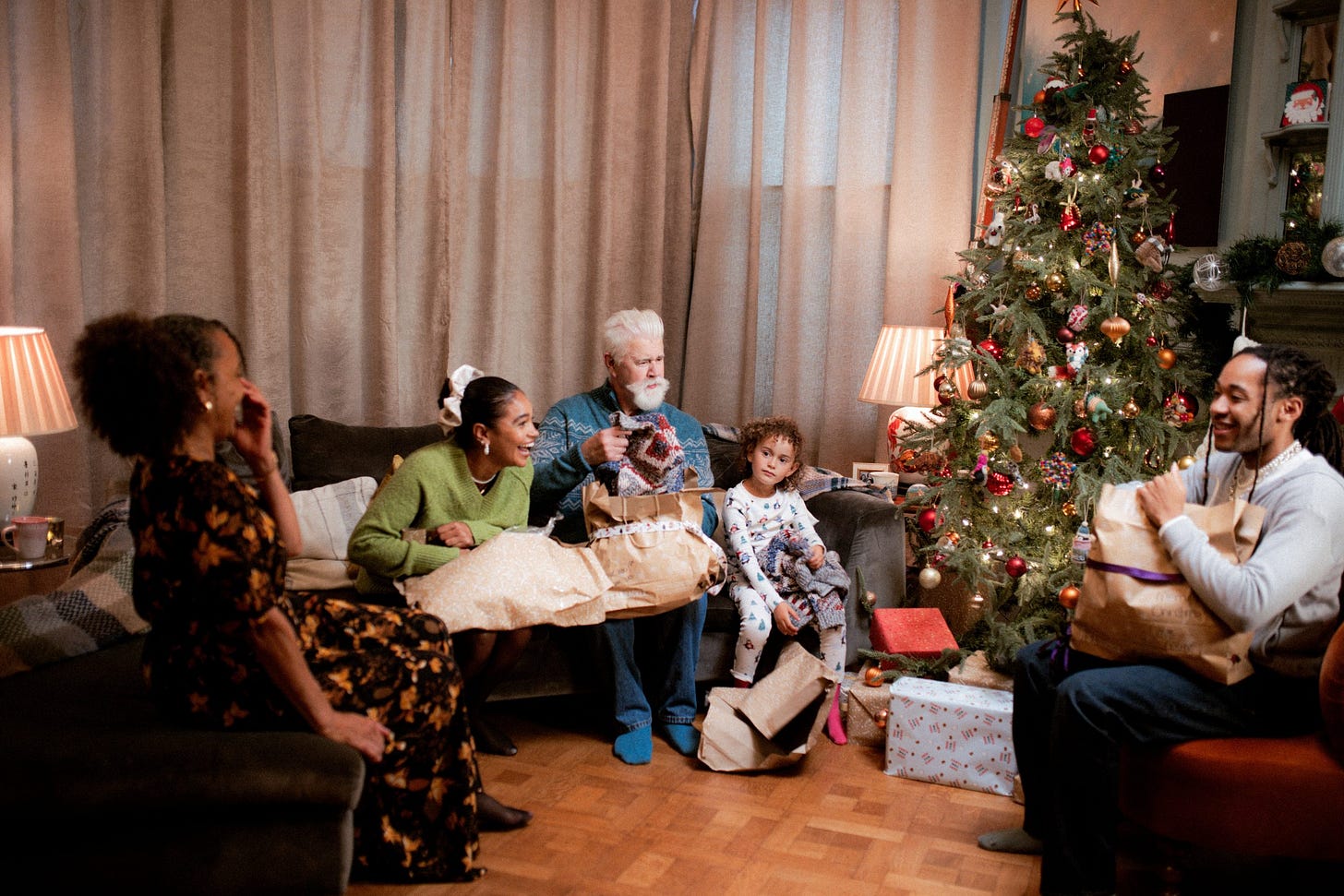My inherently problematic Christmas ad diversity audit
This year's crop of Christmas ads is ethnically and gender diverse to a fault. But there's a weird reluctance to admit it in adland.
NB: I believe this post has too many images for email, so you might have to click through to read it on Substack.
So diversity and representation in advertising has been a hot topic of late.
On one side you have the professional advocates, ranging from Unstereotype Alliance to numerous industry commentators, all of whom see urgent problems to be fixed and overdue progress to be made.
On the other side, you have the pantomime-ish ‘anti-woke’ stories churned out by the Daily Mail and elsewhere, which pounce on examples like this year’s Boots ad and try to whip up Bud Light-esque boycotts.
In the middle of all that, it’s hard to talk about the nuances of these issues in a way that doesn’t get misconstrued. Generally, it’s easier to stay out of it, especially if you know some readers are liable to judge any argument by the profile pic of the person making it: Straight white man says what about diversity? etc.
But, having written a book called The Road to Hell, I think it’s worth me exploring a case where plenty of good intentions are involved, yet no one seems especially happy with where the road is headed.
So in this post I’m going to dive into a sample group of 22 mainstream Christmas ads, and see what we can learn.
1. The #dobetter narrative
First, let’s take the temperature of adland by quoting three Campaign articles from the past month.
In ‘Looking at Christmas characters through a gendered lens’, Lori Meakin laments how “too often in creative industries, we still see people regularly… behaving as if male is the default gender, with women being either a slightly niche alternative, or overlooked entirely.” She goes on to cite the maleness of anthropomorphic characters like Monty the Penguin, Edgar the Dragon and Kevin the Carrot, though she welcomes the inclusion of Katie the Carrot. To be fair, Meakin is wryly aware of how absurd some of this sounds, but the general tone is one of ‘progress made, but more to do’, ending with a rallying cry: “Let’s magically manifest the world as it could be, not just replicate how it’s always been.”
In the same pages, Bee Pahnke makes the case for adland doubling down on the diversity agenda, despite backlash from elsewhere (‘Brands – in this era of culture wars, don’t give up on DEI&R’).
And in another article, Danny Josephs criticises the lack of disability representation—“Despite 24% of the UK population living with a disability, this year’s Christmas ads offer little to no representation for disabled communities.” He sees this as part of a general cooling of the DEI agenda: “Apart from the myriad fantasy figures, famous sorts of both genders, a handful of brown and black faces and some LGBT+ representation, this year’s crop is curiously lacking in diversity; you’d think people are starting to get bored with DEI when you watch them.”
This last part in particular brought me up short, because it’s strange to think the internal adland sentiment is that Christmas ads are lacking in diversity, when the perception from outside (and not just in the Daily Mail) so often feels different.
Thinking this might be a reflection of my own bias, I forced myself to go through all the Christmas ads to see how they rate on gender, ethnic and (to whatever extent it’s visible) class diversity.
Despite the underlying issues being serious, there’s something comical and reductive about this whole exercise, so bear with me and I’ll come back to being serious afterwards.
2. The Diversometer—Xmas ad special!
John Lewis
Features two white sisters, coded middle class. Bad start, but at least they aren’t male. Also features the mother but no father, which is more like it. Probable Asian husband (bottom left image). Non-white boyfriend (top right). Verdict: Diverse
Tesco
White male lead, coded working class = potentially problematic. But his mates at the building site are black and a mix of male/female. And he laughs at the black guy’s joke at the party, and a black/Asian couple come round for dinner. And male stereotypes are challenged by a moment of tenderness with his grandpa. Verdict: Diverse
JD Sports
Easy win—majority non-white cast, and the main white guy is ginger, which scores points. Verdict: Diverse AF
Sports Direct
Mixed-race parents, diverse football team, white male celeb, ginger girl. Verdict: Diverse
M&S Food
Older white woman of larger body type. Limited cast, but she dances with black people, plus ginger beard guy. Verdict: Diverse
M&S Clothing
Black girl lead character. Non-white cast apart from old white woman. Verdict: Diverse
Sainsbury’s
Old white male BFG is a bad start. But the hero is Sophie, the non-white woman at the shop. They go and buy salmon from a black woman on a Scottish island, and visit Grant the black cheesemaker. Verdict: Diverse
Greggs
Only has Nigella, so has to rate as undiverse. But features some nice code-play between middle-class Nigella and sort-of-working-class brand. Verdict: Sorry, still undiverse
Kevin the Carrot
Problematically male carrot, though he may score ginger points. But now there’s Katie, who is smarter than him: “Kevin, that’s the oven!” Verdict: Diverse / empowered
Morrisons
Opens on a non-white woman with a white, grey-bearded husband. Black chef, white ginger woman chef. Christmas dinner scene: old white couple, black possible couple, Asian-ish hostess, white husband. Verdict: Diverse
Asda
Garden gnomes concept is potentially white / male. But it’s salvaged by some gnomes being black, one being very camp, the boss-gnomes being female, and the two human characters including a younger female. Older white male brings it down. Verdict: Diverse-ish.
Coca-Cola
Technically no diverse casting as no humans are involved. But AI has skilfully avoided generating any white males apart from Santa himself. Verdict: Diverse
Lidl
Worryingly white. But does feature the little girl helping out the little boy, so that’s empowering. Verdict: Educate yourself, Lidl
Debenhams
A bit… lookist? But definitely trying—decent redhead and beard representation. Verdict: Diverse
Argos
Problems here. Little white blonde girl, green dinosaur and not much else. Verdict: Wrong side of history
Amazon
Possible Hispanic worker, helped out by diverse friends. Brave of Amazon to tell a tale of a downtrodden worker. For fans of Christmas synchronicity, the theatre is called Sonnet, like the song in the John Lewis ad. Verdict: Diverse Prime
TKMaxx
Very white, but there is at least a campness about the llamas. Verdict: Try harder
Boots
Black woman lead, fat white sleepy male Santa, use of they/them pronouns, largely non-white and queer-coded cast. Verdict: Knocked it out the park
Waitrose
White, middle-class murder mystery premise. But the host is a non-white woman and part of a mixed-race couple. And the guilty person is a white man. Verdict: Diverse
Barbour
Basically just sheep. Verdict: Wrong side of history
Etsy
Waldo is a white male, but he’s Irish so he’s non-colonial. He walks through an admirably multicultural city and meets Wenda, his non-white girlfriend. Verdict: Diverse but heteronormative
Fatface
Middle-class mixed-race family with own swimming pool. All black cast, plus white beardy guy. Verdict: Diverse
3. The disconnect
OK, I’ll pull back from the light-heartedness now, although I do think it helps to bring some levity to this stuff.
The reason for going through that exercise is to highlight the disconnect with suggestions that “male is the default gender, with women being either a slightly niche alternative, or overlooked entirely”. Or that the ad industry is in danger of “giving up” on DEI. Or that the ads feature only “a handful of brown and black faces”. Or that “this year’s crop is curiously lacking in diversity; you’d think people are starting to get bored with DEI when you watch them.”
Seriously, I don’t think you have to be a Daily Mail reader to think that’s a weird take. The good intentions of adland long ago created a new kind of stereotype where (to the extent that any of us pay attention) we positively expect couples in ads to be mixed-race and any women or girls to be empowered.
So much so that perfectly non-Daily-Mail people like Jon Stewart have been poking fun at this for a while, expressing mock-incredulity at the likeliness of the couple featured here—the point of the joke OBVIOUSLY NOT BEING that mixed-race couples don’t exist or, still less, that there’s something inherently funny about them. Stewart is just pointing out something that’s become a heavy-handed adland stereotype, ironically brought about by an over-earnestness about busting stereotypes at every opportunity. We know mixed-race couples exist and we’re absolutely cool with it, but it just feels like we see A LOT of them on TV—roughly 8 in the 22 ads featured above.
Like the vast majority of people, I believe advertisers should be mindful of diverse casting and it can be a subtly powerful and moving thing if you’re a gay person seeing gay people in ads for the first time. Ads can play a role in ‘normalising’ societal change, but it tends to work best when done subtly—woven into the everyday activity of the brand, rather than a ‘look at us being progressive’ diversion. That way, it ends up actually feeling normalised. But instead, a lot of ads are so self-consciously engaged in trying to create a world everyone can recognise that they end up creating a world that no one really recognises.
To look at it through a clinical mathematical lens, the England / Wales population breaks down as: White: 81.7%, Asian: 9.3%, Black: 4.0%, Mixed: 2.9%, Other: 2.1%. That obviously varies in London, but it’s not crazy for a lot of resolutely unracist people of all ethnicities in provincial England / Wales to feel like the world on TV isn’t ‘representative’ of the world outside their door.
According to Unstereotype Alliance, this diverse casting is nevertheless a direct route to profits for brands. In a ‘do well by doing good’ story similar to the one pushed by purpose for the past 15 years, the idea is that diverse casting is the smart choice as socially conscious Gen Z rises to power—and the claim is that it already accounts for 3.46% higher shorter-term sales, 16.26% higher longer-term sales, 33% higher strong consideration, 62% higher likelihood of being a consumer’s first choice, and 54% higher pricing power (all based on answers to survey questions, so the usual scepticism applies to what consumers say versus what they do).
These are big commercial claims, described as “irrefutable” in the introduction to the report. But the research makes no attempt to separate correlation from causation, or to establish which way the causation runs—i.e. do diverse brands become successful, or do successful brands routinely engage in diverse casting? And it has no control group of ‘undiverse’ brands to compare against.
In any case, based on the above, it’s hard to find any UK or US brands these days who aren’t doing diverse casting—so how do you isolate it as a causal factor separating the successful from unsuccessful brands? Are we really to believe every one of the brands above is experiencing market-beating growth, even when they’re competing against each other?
Going back to the Campaign article mentioned earlier, Danny Josephs has a point when he says there’s not much representation of disability—although when he says “the nine million deaf or hard of hearing or the two million people who are blind are completely invisible when it comes to festive ads”, he must have been writing before the Apple ad was released, which has been widely praised for its depiction of deafness (hooray) albeit in a conventional white family (boo).
The disability issue is complex. Danny Josephs cites a figure saying 24% of the UK population is disabled, using the broad definition of people who report having a physical or mental condition that has lasted or is expected to last more than 12 months, and reduces their capacity to carry out day-to-day activities. But of that high number (1 in 4 people), it’s estimated that 70-80% have a non-visible disability—i.e. the kind that won’t show up if you put them round the dinner table in a Christmas ad. Given that reality, the shorthand for depicting disability is usually to show someone in a wheelchair, which Danny Josephs understandably describes as “the default ‘will this do?’ setting for so many brands… who use a chair as some kind of visual tick box shorthand”.
All of which puts advertisers in a bind, at least as long as we demand that ads are perfectly representative of diversity in all its forms, both re-presenting the world as it is, and ‘manifesting the world as it could be’, all without being tokenistic and all while mass-marketing stuff effectively and entertainingly, which is the main purpose of the exercise.
4. The challenges
Right now, I see four challenges that don’t get talked about much.
First, there’s the fine line between respectful representation and tokenistic box ticking, and it can be a hard one for a 30-second ad to tread. If some of the ads above had managed to feature a wheelchair around the Christmas table or a gnome with a hearing aid, then maybe it’s processed as heartening representation by some, but it could equally be processed as tick-box tokenism that patronises the communities involved.
Second, many of the vectors of diversity that matter aren’t visible. We have no idea if JR Hartley was gay, or had the hidden disability of early-stage dementia. We don’t know if Gio Compario was private schooled, or orphaned at an early age, or has bipolar disorder. We can only tell someone’s class if obvious indicators are used, like the white-van-driving building site guy in the Tesco ad. But ‘obvious indicators’ is a synonym for ‘stereotypes’. Ads use them all the time, because they’re a shortcut when telling a story.
And they’re hard to avoid. Recent years have seen woman-with-a-sledgehammer become the key signifier of empowerment for Jaguar, Dove, B&Q and others. (Beyoncé has a baseball bat, but it still counts.) The very symbol of busting stereotypes has become its own stereotype.
Thirdly, many ads only feature a small cast—maybe 4 people in a group of friends or a family scene. If every perfectly well-intentioned ad agency casts those four people with an eye to diversity, the unavoidable maths of the situation is that you end up with an adland that doesn’t look very like the real world and disproportionately emphasises easily identifiable diversity over other forms.
And lastly, many ads can’t show diversity because there just aren’t any humans. Cadbury’s gorilla, Smash Martians, Dumb ways to die, Honda cog. I don’t know how those ads would rate on the Unstereotype Alliance index, and you semi-seriously wonder if brands might avoid them these days because it’s a missed opportunity to boost your end-of-year DEI metrics. But they remain among the most popular ads of recent decades, and it remains an eternal truth that most good ads basically involve anthropomorphic animals.
5. White guy’s conclusion
All of the above is not intended to say diversity doesn’t matter, but I sense a widening gap between adland’s ‘must try harder’ narrative, and the public’s ‘honestly, we get it!’ response. If nothing else, I hope this audit means the conversation can be grounded in some kind of shared reality—because it’s almost like people are looking at the same ads and seeing different things.
Other than that, I’ll tiptoe away and pour myself a brandy. Thanks for reading this year, and it’s not too late to order an amazing Christmas present if you feel inclined.
Oh, and to end on a wholesome note, I love this ad for an actually purposeful (non-profit) organisation. It’s a poetic way to depict hidden loss, and without the torturous dismount of a Maltesers logo at the end. I wrote about it here.




























Thanks for braving the advertising over-diversity subject. It's been an obvious source of incredulity for viewers, yet no one company can dare to ignore it for fear of being pilloried online.
It's not just the challenge of showing diversity in one ad with a limited cast - it's compounded in an ad break when each successive ad shows the same ironically undiverse set of multiracial, multigendered, multi-everythinged families and friends. This undermines any attempt of the ads to belong to the same world that its consumers live in. Armando Iannucci's David Copperfield succeeded brilliantly with a colour-blind cast, because they were all wonderful actors who brought Dickens' characters to life. In corporate ads the cast are just personas - representatives rather than people.
I sympathise with advertisers - I'm not sure how they get out of the casting hole they've dug themselves into now. But I agree that they should move away from trying to project moral purity, and perhaps focus on telling us why their products are better?
(And I love the Tommy's ad - not sure I'd ever have seen it otherwise.)
We in advertising need to learn to simply ignore professional pressure groups or individuals whose livelihoods or sense of purpose is derived by playing gotcha on a specific topic, and who don't represent anyone but themselves.
Totally ignore the outside groups and be honest and respectful with your employees (who frequently act as voices on this topic, and who also don't speak for anyone buy themselves): "We do cast for diversity, and with ~7 actors to cast in any round of production, we're never going to tick every box. The casting also has to serve the story, not the other way around."